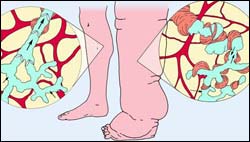Breakthrough in understanding of hereditary disease of lymphatic vessels

Normal lymphatic capillaries (light blue) are devoid of smooth muscle cells, whereas the collecting lymphatic vessels are surounded by a smooth muscle cell layer (orange), which pumps the lymph forward. They also contain valves that prevent the backflow of the lymph. The lymphatic capillaries in the legs of patients who have FOXC2 mutations are abnormally shaped and surrounded by smooth muscle cells. This prevents the efficient uptake and flow of the lymph. Lack of valves in the collecting lymphatics leads to lymph backflow. (Drawing by Paula Saarinen)
A study from the Ludwig Institute for Cancer Research (LICR) Affiliate Center at the University of Helsinki in Finland has shed light on the development of lymphatic vasculature and valves, and may help to develop better treatments for lymphedema.
The disease, which results from damaged or absent lymphatic vessels, may be inherited or may be a side-effect of the surgical removal of tumors. Lymphatic vessels normally remove fluid and proteins escaping from blood capillaries into surrounding tissues, and lymphedema is characterized by the disabling swelling of legs, and sometimes arms, that results when the lymphatic vessels are unable to clear the lymph from the tissues. The current study, which was published today in Nature Medicine, has uncovered a fundamental mechanism of the formation of lymphatic vessels.
The LICR team, together with collaborators from the UK, Japan, USA and Austria, analyzed a hereditary form of lymphedema, known as Lymphedema Distichiasis (LD), which is caused by mutations in a gene called FOXC2. The team found that the lymphatic vessels of LD patients are abnormally shaped and covered with smooth muscle cells that are usually present only on blood vessels and on larger, collecting lymphatic vessels. In addition, mutations in Foxc2 led to a lack of lymphatic valves, which prevent the reflux of lymph. This is the first study that describes a gene critical for the formation of lymphatic valves, and regulation of the interaction between lymphatic endothelial cells and vascular smooth muscle cells.
According to Professor Kari Alitalo, the senior author of the study, the insights gleaned into FOXC2 function may be applicable in the development of therapies for several disorders that affect lymphatic vessel formation. “We are currently working on approaches to stimulate the proper formation of lymphatic vessels in people who suffer from lymphedema. However, FOXC2 is produced in endothelial cells of both lymphatic and venous valves, so these results may also turn out to be important for the understanding and treatment of chronic venous insufficiency, which affects 5-25 % of the adult population.”
Media Contact
More Information:
http://www.licr.orgAll latest news from the category: Health and Medicine
This subject area encompasses research and studies in the field of human medicine.
Among the wide-ranging list of topics covered here are anesthesiology, anatomy, surgery, human genetics, hygiene and environmental medicine, internal medicine, neurology, pharmacology, physiology, urology and dental medicine.
Newest articles

Properties of new materials for microchips
… can now be measured well. Reseachers of Delft University of Technology demonstrated measuring performance properties of ultrathin silicon membranes. Making ever smaller and more powerful chips requires new ultrathin…

Floating solar’s potential
… to support sustainable development by addressing climate, water, and energy goals holistically. A new study published this week in Nature Energy raises the potential for floating solar photovoltaics (FPV)…

Skyrmions move at record speeds
… a step towards the computing of the future. An international research team led by scientists from the CNRS1 has discovered that the magnetic nanobubbles2 known as skyrmions can be…





















